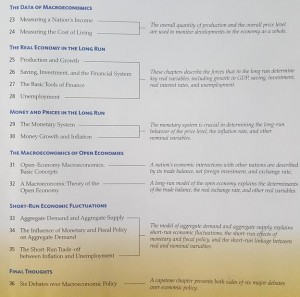| Principles of Economics II (2019.1) |
Midterm Exam. Score: [Link]
Final Exam. Score: [Link]
| Spring of year 2019 To contact T.A. (Ms Minyoung Roh) call 219-2698 during weekdays email: rohmin9122@gmail.com |
My Office : Energy Center Room 212 TA’s Office : Room 202 |
Introduction
| top |
| This course aims for the students to understand how an economy is working. The first half of the course will treat topics in consumer behavior. We will learn how consumers make decisions about what to buy and how they respond to changes in their environment. We will then proceed to firms behavior and an evaluation of the market structure. Finally, we will spare our time for various topics of Korean economy. |
- Evaluation
| top |
| I will do my best to incorporate the any form of students’ participation in the class in the evaluation.The forms of participation could be - doing homework - reading the part of textbook - presentation - performing group project, if any - attendance Since it is usually difficult to evaluate all the items above, I will use my discretion in the evaluation of the above in addition to the following strict rules:- — mid-term exam: 100 ~ 120 points (extra points may be available) - final exam: 120 ~150 points (Penalty for wrong answers and extra points will be applicable) - Attendance(ATT) : Regular in-class or electronic attendance check or and following the university rule! Pass/Fail |
- If one gets 0 points in final exam., he will get the final grade of F.
- If you miss any class, it is your responsibility to catch up no matter what!
- attendance (ATT): attendance will be checked regularly. Your status of attendance will be reflected in your grade according to university rule. It can affect your performance by either Pass or Fail.
- If you are caught for misdemeanor during the exam., you will be referred to the Student Honor Court and your final grade will be determined according to that court’s decision
1st Week - Introduction (Chapter 2, 3)
VIII The Data of Macroeconomics
2nd Week – Measuring a Nation’s Income (Chapter 23)
- Handbook on Seasonal Adjustment 2018 edition, Eurostat
- Seasonal Adjustment, Wiki
- German Input-Output Table, GDP( OECD Statistics )1, GDP2
3rd Week – Measuring the Cost of Living (Chapter 24)
- The Babe Ruth Story (1948) – Babe Ruth Hits Home Run, Cures Another Kid
- United States Consumer Price Index
- A Basket for CPI calculation (example)
IX The Real Economy in the Long Run
4th Week – Production and Growth (Chapter 25)
5th Week – Saving, Investment, and the Financial System (Chapter 26)
- Financial Intermediary
- History of public debt, US
- Public Debt vs. Unemployment
- polonius advice to laertes neither a borrower nor lender
6th Week - The Basic Tools of Finance (Chapter 27)
7th Week – Unemployment (Chapter 28)
8th Week – Midterm Exam
X Money and Prices in the Long Run
9th Week – The Monetary System (Chapter 29)
- Board of Governors of the Federal Reserve System
- Big stone as Money [Rai Stone] [Yap island Stone cash - Smithonian]
- Gold Certificate USD
- Money Multiplier
- Mary Poppins
10th Week – Money Growth and Inflation (Chapter 30)
XI The Macroeconomics of Open Economies
11th Week – Open-Economy Macroeconomics: Basic Concepts (Chapter 31)
12th Week – A Macroeconomic Theory of the Open Economy (Chapter 32)
XII Short-Run Economic Fluctuations
13th Week – Aggregate Demand and Aggregate Supply (Chapter 33)
- Sticky-wage theory : staggered contract model
- Sticky-price theory : menu cost, Mankiw, N. Gregory (1985)
- 2008 Financial crisis
- price of oil [nominal and time value adjusted]
14th Week – The Influence of Monetary and Fiscal Policy on Aggregate Demand (Chapter 34)
15th Week – The Short-Run Trade-off between Inflation and Unemployment (Chapter 35)
XIII Final Thoughts
16th Week – Final Exam
Reading Materials:
- The Scope and Method of Political Economy, John Neville Keynes, Excerpted from The Scope and Method of Political Economy, 4th ed., by John Neville Keynes, London: Macmillan, 1917[Full Text from Google E-book]
- The Method of Positive Economics, Milton Friedman, from essays in Posive Economics, by Milton Friedman, Chicago: University of Chicago Press, 1953

